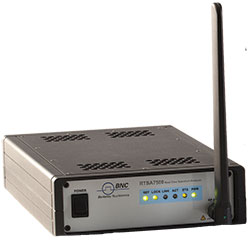
Berkeley Nucleonics’ wideband receivers enable users to operate across multiple frequency bands without spending large amounts of money on down-converters or investing time on integration. Devices in the RTSA7500 series weigh only 6 lbs. (2.7 kg) and have a footprint smaller than a standard sheet of paper, which increases deployment flexibility and the number of use cases — providing a solution for both benchtop and field applications. A rechargeable battery option further increases the portability and versatility of BNC’s high performance wideband receivers.
Disrupting the highly competitive signal analysis market was no simple task. Nevertheless, the extremely broad frequency range and large instantaneous bandwidth of the RTSA 7500 series did just that. From 100 kHz to 27 GHz, the wideband receivers provide a real-time instantaneous bandwidth of up to 100 MHz with a 100 percent probability of intercept (POI) of only 1 µs. With a spurious free dynamic range (SFDR) of 100 dBc, large and small signals are easily captured by these instruments. For applications that require refined control of resolution bandwidth (RBW) and enhanced scanning functionality, the RTSA 7500 wideband receivers are capable of a sweep speed of 200 GHz/s and RBWs as fine as 0.62 Hz.
The interface for the wideband receivers is an easy-to-use and intuitive GUI. For optimum utility and integration, APIs are available for LabVIEW, MATLAB®, SCPI, C/C++ and Python-based platforms. With these tools, users can create real-time plots of spectrum, spectrogram and persistence spectrum, as well as I/Q plots interpreted through a user-defined display.
Berkeley Nucleonics Corp.
San Rafael, Calif.
www.berkeleynucleonics.com
